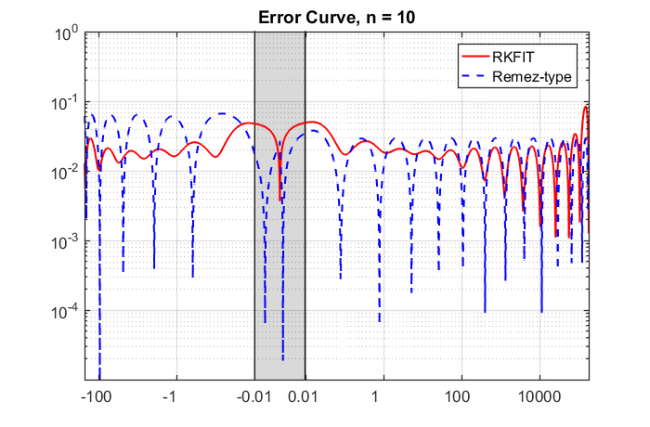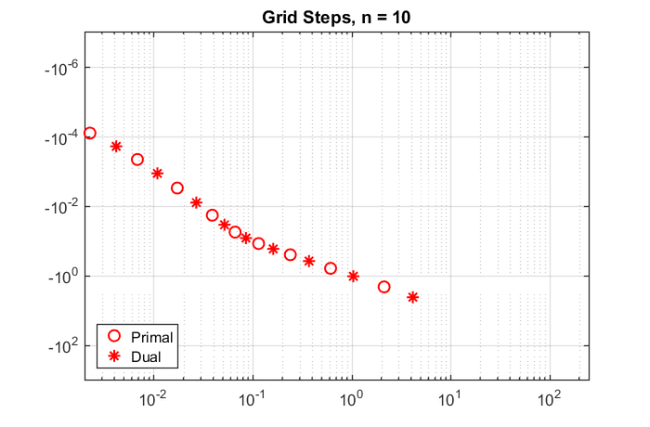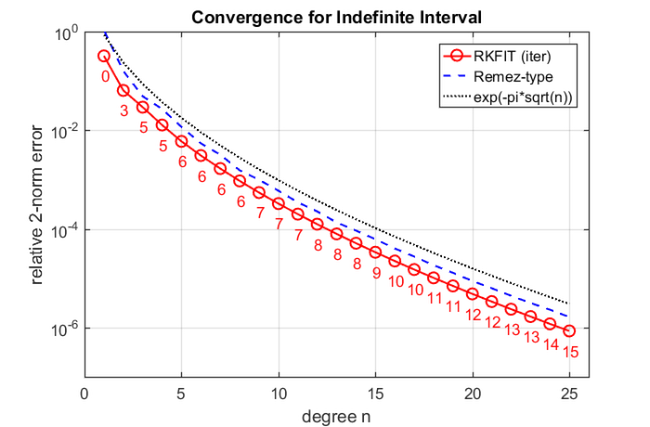Compressing exterior Helmholtz problems: Uniform approximation on indefinite interval
Stefan GüttelDownload PDF or m-file
Contents
Introduction
This script reproduces Example 6.3 in [1]. It computes RKFIT approximants for  , where
, where  is a diagonal matrix with dense eigenvalues in an indefinite interval and
is a diagonal matrix with dense eigenvalues in an indefinite interval and  . The RKFIT approximants are compared to balanced Remez approximants for the indefinite intervals.
. The RKFIT approximants are compared to balanced Remez approximants for the indefinite intervals.
The code
a1 = -225; % spectral interval bounds from the 2D Laplacian example
b1 = -1e-2;
a2 = 1e-2;
b2 = 1.7976e+05;
ee = real([ logspace(log10(a1),-16,100) , logspace(-16,log10(b2),100) ]).';
N = length(ee);
A = spdiags(ee,0,N,N);
h = 1/150; h =0;
v = [ 0 , 0 ];
ex = @(x) sqrt(x + (h*x/2).^2);
F = spdiags(ex(ee),0,N,N);
b = ones(N,1); b = b/norm(b);
Initialize RKFIT parametes.
param = struct; param.reduction = 0; param.k = 1; % superdiagonal param.tol = 0; param.real = 0; for m = 1:25, % run rkfit with training vector param.maxit = 30; xi = inf*ones(1,m-1); % take m-1 initial poles [xi,ratfun,misfit,out] = rkfit(F,A,b,xi,param); if m==1, err_rkfit = out.misfit_initial; iter_rkfit = 0; else err_rkfit(m) = min(misfit); iter_rkfit(m) = find(misfit <= 1.01*min(misfit),1); end % uniform balanced Remez approximant zolo = rkfun('sqrt0h',a1,b2,m); err_zolo(m) = norm(zolo(ee(:)).*b - F*b)/norm(F*b); if m == 10, % some plots for m = 10 % get best ratfun [~,it] = min(misfit); param.maxit = it; xi = inf*ones(1,m-1); % take m-1 initial poles [xi,ratfun,misfit,out] = rkfit(F,A,b,xi,param); figure semilogy(NaN); hold on lint = util_log2lin([b1,a2],[a1,b1,a2,b2],.1); fill([lint(1:2),lint([2,1])], [1e-25,1e-25,1e15,1e15], ... .85*[1,1,1], 'LineStyle', '-') ylim([1e-8,10]) ax = [ -10.^(5:-2:-3) , 0 , 10.^(-3:2:5) ]; linax = util_log2lin(ax,[a1,b1,a2,b2],.1); set(gca,'XTick',linax,'XTickLabel',ax) xx = [ -logspace(log10(-a1),log10(-b1),1000) , linspace(b1,a2,200) , ... logspace(log10(a2),log10(b2),1000) ]; xx = union(xx,ee); xxt = util_log2lin(xx.',[a1,b1,a2,b2],.1).'; eet = util_log2lin(ee.',[a1,b1,a2,b2],.1).'; hdl1 = semilogy(xxt,abs(ratfun(xx) - ex(xx)),'r-'); hold on hdl2 = semilogy(xxt,abs(zolo(xx) - ex(xx)),'b--'); legend([hdl1,hdl2],'RKFIT','Remez-type ') xlim([0,1]), ylim([1e-5,1e-0]) title(['Error Curve, n = ' num2str(m) ]) grid on, set(gca,'layer','top') ax = [ -10.^(2:-2:-2) , 10.^(-2:2:5) ]; linax = util_log2lin(ax,[a1,b1,a2,b2],.1); set(gca,'XTick',linax,'XTickLabel',ax) % plot residues figure [resid,xi] = residue(mp(ratfun),2); resid = double(resid); xi = double(xi); semilogy(xi,'rx') xlim([-4e4,1e4]), hold on labels = num2str(abs(resid),'%0.1g'); hdl = text(real(xi)+1e3, imag(xi)*1.1, labels); set(hdl,'Color','r','FontSize',16,'Rotation',0) set(hdl(end),'Rotation',0) title(['Poles and Abs(Residues), n = ' num2str(m)]) grid on % plot grid steps figure [grid1,grid2,absterm,cnd,pf,Q] = contfrac(mp(ratfun)); grid1 = double(grid1); grid2 = double(grid2); loglog(grid1,'ro'), hold on loglog(grid2,'r*') legend('Primal','Dual','Location','SouthWest') title(['Grid Steps, n = ' num2str(m)]) grid on, axis([2e-3,2.5e2,-1000,-1e-7]) end end % for m
Warning: Negative data ignored > In is2D>testOneAxes (line 31) In is2D (line 24) In legend>make_legend (line 300) In legend (line 254) In example_ehcompress3 (line 108) In evalmxdom>instrumentAndRun (line 109) In evalmxdom (line 21) In publish (line 189) In x_examplepublish (line 96)



figure semilogy(err_rkfit,'r-o'), hold on semilogy(err_zolo,'b--') bnd = exp(-pi*sqrt(1:m)); % *sqrt(2) in the exponent for [0,b2] semilogy(20*bnd,'k:') xlabel('degree n'), ylabel('relative 2-norm error') legend('RKFIT (iter)','Remez-type','exp(-pi*sqrt(n))') labels = num2str(iter_rkfit(:),'%d'); hdl = text((1:m)-.4,err_rkfit/4, labels,'horizontal','left','vertical','bottom'); set(hdl,'FontSize',13,'Color','r') axis([0,m+1,1e-7,1]), grid on title('Convergence for Indefinite Interval')

Conclusions
The error of the Remez-type approximant, as well as the RKFIT approximant, seems to reduce like  . This is plausible in view of the results by Newman and Vjacheslavov: they showed that the error of the best uniform rational approximant to
. This is plausible in view of the results by Newman and Vjacheslavov: they showed that the error of the best uniform rational approximant to  on a semi-definite interval
on a semi-definite interval ![$[0,b_2]$](example_ehcompress3_eq04877356153534426542.png) reduces like
reduces like  with the degree
with the degree  ; see Section 4 in [2]. Here we seem to lose a factor of
; see Section 4 in [2]. Here we seem to lose a factor of  because we are approximating on the union of two semi-definite intervals.
because we are approximating on the union of two semi-definite intervals.
Other examples
The other examples in [1] can be reproduced with the following scripts:
Figure 1.2 - an infinite waveguide with two layers
Example 6.1 - constant coefficient and 1D indefinite Laplacian
Example 6.2 - constant coefficient and 2D indefinite Laplacian
Example 7.1 - truly variable-coefficient case with 2D indefinite Laplacian
References
[1] V. Druskin, S. Güttel, and L. Knizhnerman. Compressing variable-coefficient exterior Helmholtz problems via RKFIT, MIMS EPrint 2016.53 (http://eprints.ma.man.ac.uk/2511/), Manchester Institute for Mathematical Sciences, The University of Manchester, UK, 2016.
[2] P. P. Petrushev and V. A. Popov. Rational Approximation of Real Functions, Cambridge Univ. Press, Cambridge, 1987.